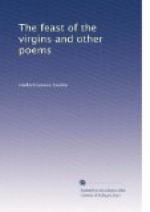[70] Pronounced Ahng-pay-too-wee—The Sun; literally the Day-Sun, thus distinguishing him from Han-ye-tuwee (Hahng-yay-too-wee) the Night Sun (the moon). They are twin brothers, but Anpetuwee is the more powerful. Han-ye-tuwee receives his power from his brother and obeys him. He watches over the earth while the sun sleeps. The Dakotas believe the sun is the father of life. Unlike the most of their other gods, he is beneficent and kind; yet they worshiped him (in the sun-dance) in the most dreadful manner. See Riggs’ Tahkoo Wakan, pp. 81-2, and Catlin’s Okeepa. The moon is worshiped as the representative of the sun; and in the great Sun-dance, which is usually held in the full of the moon, when the moon rises the dancers turn their eyes on her (or him). Anpetuwee issues every morning from the lodge of Han-nan-na (the Morning) and begins his journey over the sky to his lodge in the land of shadows. Sometimes he walks over on the Bridge (or path) of the Spirits—Wanage Ta-chan-ku,—and sometimes he sails over the sea of the skies in his shining canoe; but somehow, and the Dakotas do not explain how, he gets back again to the lodge of Hannanna in time to take a nap and eat his breakfast before starting anew on his journey. The Dakotas swear by the sun, “As Anpetuwee hears me, this is true!” They call him Father and pray to him—“Wakan! Ate, on-she-ma-da”—“Sacred Spirit,—Father, have mercy on me.” As the Sun is the father, so they believe the Earth is the mother, of life. Truly there is much philosophy in the Dakota mythology. The Algonkins call the earth “Me-suk-kum-mik-o-kwa”—the great-grandmother of all. Narrative of John Tanner, p. 193.
[71] The Dakotas reckon their months by moons. They name their moons from natural circumstances. They correspond very nearly with our months, as follows:
January—Wee-te-rhee—The Hard Moon; i.e.—the cold moon.
February—Wee-ca-ta-wee—The Coon Moon—(the moon when the coons come out of their hollow trees).




